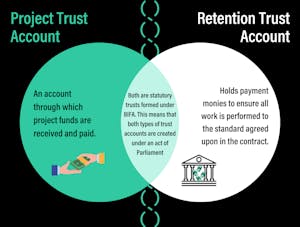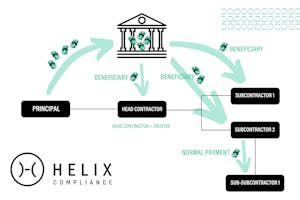What is KISS and how does it help when explaining Project Trusts?
I am a great believer in adopting the KISS strategy when writing my articles. I am forever reminding myself to ‘keep it simple stupid’ when explaining things, especially around Project Trusts. The fact that I am not a lawyer normally makes this approach an attractive option that I can easily adopt.
Am I saying that industry parties should ‘Kiss Trusts’?
Well some Subcontractors that have fought for the introduction of a Statutory Trusts regime in QLD may well feel this way. Other affected parties who have been fierce opponents of Trusts may feel very differently! However, this article does not focus on whether Trusts are good or bad for the industry. We all will have plenty of time in the future to accesses the effectiveness of Trusts in terms of improving SOP outcomes.
The heading reflects a fundamental belief of mine in how I go about writing articles for the benefit of contractors, workers, suppliers and other industry parties directly affected by Government regulation.
So to be clear, this is me, reminding myself as stupid, to keep things as simple as possible.
In my view, KISS writing is the hardest form of writing. Even as a non-lawyer, I could churn out many more articles if I was content to explain complex and difficult things in very formal and conventional terms, but therefore not capable of being easily understood by the average Joe. However, breaking down “complex legislative schemes, such as this one ……………..”, (new Project Trusts regime) as stated by the Government in relevant Explanatory Notes, in simple but accurate means, has for me proven to be the most difficult article writing task I have ever undertaken.
Furthermore, the fact of the matter is that ALL legislation is:
- written by lawyers;
- for politicians to consider and debate, who in the main have law and or art degrees, and then on the passing of legislation;
- for lawyers or legally qualified persons to be the overwhelming communicators of information to the general public on its interpretation, means;
Surprise, surprise, the information disseminated to the general public is to varying degrees, legally focused.
Now let me be clear, lawyers play a very important role in ensuring that legislated requirements and standards are developed, reviewed and adhered to by industry parties. The construction industry is strengthened and indeed protected by laws that meet community expectations. Lawyers play a very important role in ensuring the industry is sustainable for all parties performing work, but also parties that contract for work to be carried out are suitably protected.
However, legislation developed, debated and then extensively commented on in this ‘legal bubble’ means that the average industry punter in many instances has no UNDERSTANDING on how it will impact them because of the heavily based legal language used. A lot of commentaries I see of this nature are ‘double dutch’ to the average worker, supplier or contractor. In other words, the language used cannot be understood by these parties.
Of course, these parties can and should in many instances seek advice from specialists, excellent construction lawyers, like we have at Helix.
However, if someone like me, who has spent my entire working life of 50 years, breaking down legislation and simply and accurately explaining it in general terms to affected parties, was on the blink of hosting a white flag up and acknowledging that this approach just could not be done concerning Trusts, then I think this confirms, in my mind anyway, how complex and indeed unwieldy this legislation is.
In my view, the general basis of a far-reaching and disruptive legislative initiative such as this Trust regime must be capable of being explained to affected parties without them having to get a lawyer on the phone.
I am talking about a high-level understanding of the regime.
However, I persisted and it will be up to others to judge whether I have managed to do a KISS article on Project Trusts.
A note regarding a ‘tactic’ I have employed in writing this article. I will repeat some crucial information, slightly differently, as a means of hopefully, readers gaining an understanding of important aspects of the new Project Trusts regime.
Let’s go!!
There are two types of Trust Accounts under the Building Industry Fairness (Security of Payment) Act 2017 (BIFA) Trust Account framework:

There are two very important aspects of both these Trusts, namely who is the Trustee and who are the beneficiaries. I will discuss these elements in detail later in this article.
In this article, I will only be addressing Project Trusts.
What are Project Trusts?
A Project Trust is a bank account through which progress payments required under an eligible contract between the contracting party and the contracted party are paid and distributed to the contracted party and Subcontractors.
I will explain later what is an eligible contract because it is somewhat complex but we will now address the definition of contracting party and contracted party.
The contracting party is the party to an eligible contract for whom the contracted work is to be carried out for.
The contracted party is the party required to complete work under the eligible contract, whether by:
- carrying out the work personally; or
- directly or indirectly causing the work to be carried out.
From this point onwards:
Contracting party = PRINCIPAL
Contracted party = HEAD CONTRACTOR

Why?
Because, for 2022, there is only one currently known instance where an entity other than a Principal could be a contracting entity and an entity other than a contracted party could be the Head Contractor.
This one instance is when a Subcontractor is a first-tier Subcontractor AND is a related entity (I will explain later on who is a related entity) of the Head Contractor AND a head contract is an eligible contract requiring the establishment of a Project Trust.
In this instance, the first-tier Subcontractor will be the contracting party and a Sub-Subcontractor will be a contracted entity.
Now back to the normal situation.
The Trustee of an eligible contract is the Head Contractor for the contract that requires the Project Trust. The Head Contractor is responsible for establishing and administering the Trust.
The Head Contractor as the Trustee pays all first-tier Subcontractors (Subcontractors to the Head Contractor) engaged only from this account. They are known as Subcontractor beneficiaries of the Trust because of obtaining an advantage from the Trust.
The Head Contractor as the Trustee also pays themselves from this account. That is right, the Head Contractor is both the Trustee and a beneficiary.
The Project Trust account is separate from the Head Contractor’s personal or business accounts.
Let’s go over this again saying it slightly differently!!
A Project Trust is a Trust over monies paid by the Principal to the Head Contractor for an eligible contract, monies paid by the Head Contractor to the Subcontractors and monies deposited into the account as required under BIFA to address such things as money shortfalls.
The Head Contractor is the Trustee of the Project Trust and becomes the Trustee when the Project Trust is established. They are also a beneficiary of the Trust.
A Project Trust applies to amounts paid by the Principal to the Head Contractor and amounts paid by them to Subcontractors. Also captures additional amounts deposited as required (e.g. money shortfalls).
A Subcontractor for an eligible contract is a beneficiary if they have entered into a first-tier Subcontract, the contracted work is protected work or the supply of related services and the contract price for its Subcontract is at least the minimum contract price set by regulation. Presently there is no regulation of this nature in effect.
Let’s pause and go over some very important points I made above.
- All first-tier Subcontractors that are contracted to the Head Contractor to carry out protected work are beneficiaries under an eligible contract.
- All first-tier Subcontractors that are contracted to the Head Contractor to supply related services are beneficiaries under an eligible contract.
A Subcontractor’s beneficial interest is an amount they are entitled to be paid.
For the Head Contractor as a beneficiary, the amount held in Trust after subtracting all amounts Subcontractors are entitled to be paid.
Come back next week for Project Trusts – KISS Method Part 2!
Be sure to visit our Helix Insight page or social media to be updated about part 2 of this article.
Subscribe to David’s Monthly Trust Wrap Up.
David Cahill and our Helix Compliance team are all about providing you with the resources and education to navigate Statutory Trusts. To receive free monthly updates on how Trusts are affecting the industry and any tips on how to prepare, SUBSCRIBE BELOW!



